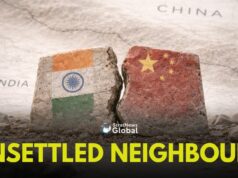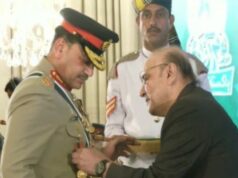NEW DELHI: With the Chinese virus sweeping through the globe, causing death and ravaging livelihoods and economies, many countries like India may have to downgrade budgetary allocations (including in Defence) going forward. Although there will be cuts, they shouldn’t be so deep as to compromise our entire national security framework, says Army Chief General MM Naravane. Speaking exclusively to StratNews Global Editor-in-Chief Nitin A. Gokhale, Gen Naravane says expenditure on defence should be seen as an investment and only when a nation is secure it prospers. What should also be kept in mind, as the General says, is that there are two neighbours that are inimical to our country. And that India is a security provider for the whole of South Asia. Gen. Naravane, who recently visited Jammu & Kashmir, says if Pakistan’s strategy has been of death by a thousand cuts, India’s strategy will be of death by a thousand and one cuts.
TRANSCRIPT
Q: The Indian Army always at the forefront, in war and in peace. And it’s no different this time when the COVID-19 pandemic is sweeping the world and of course affecting India. Apart from contributing to the national effort, the Indian Army continues to train, equip and be ready for any eventuality if it comes to the crunch. You’re on StratNews Global and I’m Nitin Gokhale. I’m privileged to have with me the Chief of the Indian Army, General MM Naravane, speaking to us exclusively on the Indian Army’s plans this year and, of course, in the future.
A: Thank you very much, Nitin.
Q: You’re about to complete about four months being in this chair; you took over on 31st of December 2019. How has been the experience so far? What have been the main challenges?
A: Well, the experience so far has, of course, been very nice. When I had taken over, during the Army Day press conference, I outlined some of my guiding philosophy—allegiance, belief, continuity, integration, training personnel and quality—and I’m trying to build on those. When I took over, I had two years and four months as my tenure as the Chief; these four months as you have pointed out, I have used it to go around to various formations, see the situation on the ground. And based on that, to try and formulate what the roadmap should be for the two years to come. These four months have been very interesting because I have visited places where I had not been since my days as a Second Lieutenant. This refresher was required so that I can take a holistic view of the entire Army, see inputs from the ground so that we don’t go wrong as we go ahead.
Any Chief would always like to further improve upon whatever he has inherited and further enhance the operational standards, the operational readiness and make his force more fighting-fit. We are working towards that. We have identified how we can further enhance our standards and that will be as a result of a combination of different force structuring or structures. Once we decide upon that, how to manage this new force in terms of equipment, arms, manning staffing levels, and once these two things are in place, then what would be the way that we strategize or change strategy in keeping with the changing times and amendments to our tactics, techniques, procedures.
So keeping all this in mind, I am in the process of formulating certain goals—short term, medium term, long term—and I hope that I should be able to achieve at least a majority of those. These goals will address all these issues without leaving anyone behind. It will address all arms and services, it will address equipment, modernization issues, HR concerns, so on and so forth.
Q: That’s great to know because you’ve actually encapsulated your vision and your planning for the force itself. But in the middle of all this, we have been hit, the world has been hit by the COVID-19 pandemic. It’s unprecedented in its fury and spread. I know that the Indian Army is at the forefront of this battle. Give us some idea about what the Indian Army is doing and how it is helping the national effort?
A: The COVID crisis has certainly been a very disruptive influence. We always have been talking about Black Swan events and theorising about that but we never really expected that to actually happen.
Therefore, this has come as a disruptive influence. Seeing it at a larger level, it is going to make a difference in how we operate in the future, in our way of life and I’m talking beyond the army also.
This is something which we will have to factor in, not only COVID but similar kinds of things. Whenever we do anything in the future, we will have to do it under this kind of overhang so that we don’t get taken by surprise ever again.
As far as the COVID battle is concerned, we had been monitoring the global situation and the internal situation. Based on that and the inputs that we were getting, we had taken some remedial measures as early as middle of February. I had made a point that force preservation is my main task. My force needs to be absolutely fighting fit. Unless my Army is fit and free from infection, I will not be able to do the full justice to the entire gamut of roles that have to perform both guarding the borders, looking after the counter insurgency, counter-terrorism grid, both in the north and northeast as well as to come to the aid of the civil administration as required.
Fortunately, we have not had too many (Coronavirus positive) cases. We have had 14 cases so far only and out of that, two have already recovered and back on active duty. That part is well under control. As far as the assistance to the civil administration are concerned, we were the first to set up a quarantine camp, which came about at Manesar, that is where the first lot of people came over evacuated from Wuhan. After that we made two more camps as Jaisalmer and Jodhpur, both catering to about 700 and 500 each, where evacuees have come from various parts of the world. And after having done their mandatory quarantine and testing, and so on and so forth, we even send them back to their home states. And the strength in those camps has now come down from 400-500 to about 100-150.
Q: But the COVID has also altered many of the old notions, old training methods and doctrines. What is new that you have done or some innovative methods that you have adopted for adjusting your training, transporting personnel? Give us some ideas on that
A: If you see the effect of the COVID, there are certain positives and negatives by virtue of being in the army. If you look at the positives, positives are that we are in our military camps and our cantonments, which are as it is isolated from the general populace. So that has been an advantage and of a benefit to us in trying to keep ourselves secure. That has definitely helped and I’ll come to that a little later. But the negatives is that we have to operate in close proximity with each other, especially in border areas, when we are doing our operations in the hinterland if you’re in an ambush, you have to be close together, you can’t stay 5-5 metres apart.
Certain things we can modify, adapt; in certain things, we have to be together. Being together, it has been of a benefit to us that we have been segregated from the population—especially in the border areas, in J&K, at high altitudes. They can continue operating as per the teachings. Therefore, it has been a positive in that sense.
Q: In terms of training, your personnel must have been on leave, you had to need to run some military specials. In that sense, Army, of course, has a great ability to do logistics under adverse circumstances but in this case, did you have to go out of the way to get the planning done—worked with the civil administration, the Railways, how have you managed to do that? About two lakh personnel had to go out and come back is what I heard or read somewhere. Is that correct?
A: When the lockdown was announced and we came to know that so many of our personnel will have to remain wherever they are, whether boys on course will have to remain where they are undergoing training, whether it is Mhow, Bangalore or Ahmednagar, wherever they are. Plus another category was on leave. Now, as far as the people who are in training institutions are concerned, they are as it is isolated. So, we could say in a sense that they are already green. So, for them to be moved out was not really a problem. The problem was how to move them out. For which we went in for these military specials, which were, of course, themselves sanitised. So that was a green component moving with a mode of transport which is green and getting down at the other end which is also a green area—our designated units are transit camps. So the entire route was green channel where they can move around.
Now, coming to personnel on leave. When they start coming back, we will first have to quarantine them for 14 days. It is only after that that they will be declared green and then the same system can start. While in the first phase, we are moving out the people on courses but they’re already safe. Simultaneously, we’ve asked people to start rejoining at the nearest army unit so that they can go through this period of 14 days quarantine and testing if required.
When the first phase is over, we will be able to start Phase 2. We have such things put into motion right after force preservation. The next task that comes is force regeneration. When doing this task, we cannot do it endlessly. The other lot has to go on leave. This is a continuous cycle. As I said, you will have to now make processes, assuming that this COVID threat is not going to go away anytime soon. Throughout the year, we will have to do something like that.
Q: Apart from the immediate things that you have done, I also want to look at the larger issue. I remember talking about asymmetric threats, non-traditional security threats. Now, it’s clearly proved that a pandemic like this is a possibility. It’s a real possibility across the globe. In that sense, the army is the best prepared force, anywhere in the country, most of the countries rather. Your doctors have done tremendously well, in terms of protocols, in terms of giving help to civil administration and all that in the future. When you look at force structuring and force preservation that you have spoken about, also your doctrines. You will have to factor in all this? How will you do it? And that’s the question? Because you’ve just postponed your army commanders conference. I’m sure you’re still talking about it, how to go about it. Can you give us some idea on that?
A: As a result of this, of course, we will have to rethink on how we will be fighting in the future. And we have, in fact, doing some brainstorming on this as we speak. We’re taking inputs from our regional commands and trying to draw out a roadmap. But that said, we’ve always had capability to fight in a NBC (nuclear biological chemical warfare) environment. It is not that we do not have any capacities or capabilities at all, but probably we will have to build further on them, may not be to that high intensity as a classical NBC environment is concerned, But lower intensity to cater to such kind of pandemics, which may not be that serious as far as mortality is concerned.
Q: So, CBRN which used to be like, you know, one of the peripheral issues will take centre stage in the future planning and future doctrines and tactics that will come. That’s what I’m guessing as you mentioned just now. But let me come to the more mundane issues like you have had this plan your predecessor had made this plan about IBGs (Integrated Battle Groups) and the restructuring of the army, making a leaner and meaner force, the Shekatkar Committee report. How will that now get factored into all this? How will that get affected?
A: This restructuring is the one to get affected in that sense, as I mentioned right at the beginning, when you’re going for a more efficient, try to enhance the effectiveness of the force. Those three, four factors come into play, and one of them is force restructuring. That is very much still a work in progress. We have identified the formations which will undergo this change in the first phase. It is only that things have now got delayed because of not being able to move out and actually put that into motion. But that is something which is going to happen. The IBG concept will happen. The restructuring of the Army Headquarters will happen. That is the way for the future. There is no doubt in my mind that future wars will be going in that direction.
Q: So in that respect one more concern that is being expressed across the specialist field of defence and defence analysis is also about the pressure under which the defence budget will come, given the precarious economic condition that is going to be staring the country in the face, just not at our country but all the countries across the globe. Probably in that sense, will lower defence budgets or squeezed defence budgets affect your modernization plans, your replenishment plans, how are you looking at that challenge going forward?
A: Firstly, as far as the budget is concerned, I would like to make one point that it is government’s responsibility to provide for its citizens a safe and secure environment. Only when you have a safe and secure environment can the country flourish. So, expenditure on defence should be seen as an investment. We also contribute through the armed forces. And if you see past incidents which have taken place, whether it is 26/11, Doklam or the Parliament attack, whenever such incidents have happened, invariably the stock market has gone down. It shakes investor confidence. Keep the armed forces strong, no matter what! And it is because the country is strong and it is able to face these challenges that the economy remains robust. So, we have to continue investing in national security. I’m not just saying army or armed forces. When the nation is secure, the nation prospers. Therefore, investment in that has to continue. No matter what the circumstances, that cannot be allowed to decline.
We have two neighbours that are inimical to us. That is not going to change. Once again, we have to face the facts. Even though there will be cuts, they cannot be so deep as to compromise our entire national security framework. After all, we are not only looking at our own security, but we are a security provider for the whole of South Asia, India is a pillar of stability. We cannot be seen to be faltering.
Q: Very well put there Gen Naravane. Talking about neighbours, you recently went to Jammu and Kashmir and you also mentioned there that the western neighbour Pakistan is continuing with its attempts to send in infiltrators and continuing the proxy wars. What is your sense? Are they not in a precarious or more precarious condition than India is, economically and otherwise?
A: Well, yes. And in fact, this is a strategy which they’ve been pursuing for more than two decades now. The strategy has not borne fruit. Why they’re persisting with the strategy which is failing really beats the imagination. First thing that we are taught in the army is that don’t reinforce failure. But they just seem to be doing that. Theirs is a strategy of death by a 1000 cuts, our strategy will be death by a 1000 and one cuts. That ‘plus’ advantage will always be with us. They will never succeed.
The sooner they realise that it is a failed strategy, the better. It will augur well for both countries to have peaceful borders; both of us can grow. I can only leave it at that. Good sense has to prevail. Otherwise, it really beats me why they should continue with a strategy which is not paying any dividends to anybody.
Q: Gen Naravane, thank you very much for your time and for being so frank about whatever the Army is doing and is planning for the future. Hopefully, we will all come out of this COVID-19 crisis unscathed and with our health intact. We hope to see you sometime again on this programme but for the moment, thank you very much.
A: Thank you. (It’s) always a pleasure to talk to you.
Nitin A. Gokhale is a media entrepreneur, one of South Asia's leading strategic affairs analyst and author of over a dozen books so far on military history, insurgencies and wars.
Starting his career in journalism in 1983, he has since led teams of journalists across media platforms.
A specialist in conflict coverage, Gokhale has covered the insurgencies in India’s North-East, the 1999 Kargil conflict and Sri Lanka’s Eelam War IV between 2006-2009.
Gokhale now travels across the globe to speak at seminars and conferences, and lecture at India’s premier defence colleges. He has founded three niche portals, Bharatshakti.in, stratnewsglobal.com and Interstellar.news.




